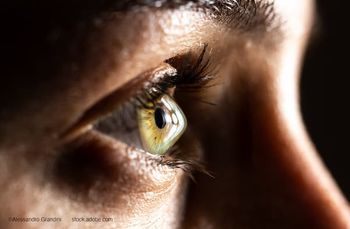
Trabeculectomy with MMC, glaucoma implant considered equally viable choices
Las Vegas-In pediatric eyes with uncontrolled aphakic glaucoma and no history of previous surgical intervention, trabeculectomy with mitomycin-C (MMC) and placement of an Ahmed glaucoma implant (AGI, New World Medical) result in comparable outcomes with respect to successful IOP control and rate of complications, according to the findings of a prospective, randomized study undertaken at the Shaheed Beheshti Medical University, Tehran, Iran.
The trial enrolled 30 eyes of 28 patients between 2003 and 2005 that were equally assigned to undergo one of the two surgical procedures. Minimum follow-up for all eyes was 6 months, and the maximum ranged to 36 months in both groups.
At last follow-up, overall success rates were not significantly different in the trabeculectomy and AGI groups. Overall success included any eye with an IOP >5 mm Hg and ≤ 21 mm Hg while on two or fewer medications, and the rates were 73.3% among trabeculectomy eyes and 86.7% in the AGI group.
"Aphakic glaucoma has been reported to occur in up to 41% of pediatric eyes following cataract extraction, and while trabeculectomy with MMC or placement of a glaucoma drainage device are performed most often when IOP cannot be controlled with medications, there is no consensus about what represents optimal surgical management," he said.
The prospective study was undertaken, Dr. Pakravan said, because most previous studies of surgical treatment for pediatric glaucoma have not focused specifically on aphakic eyes. Although the study is limited by a relatively small population and length of follow-up, "its results suggest either trabeculectomy or an AGI may be considered as primary surgical intervention for uncontrolled glaucoma in aphakic pediatric eyes," he said. "Selection between these two techniques should be based on other factors, including surgeon's preference and experience, as well as the quality of the conjunctival tissue and its mobility."
Patients were eligible for the study if they were under 16 years of age and had undergone lens removal and vitrectomy for a congenital cataract. Patients with a history of any other ocular surgery were excluded, as were children with cataracts associated with persistent fetal vasculature or intrauterine infections.
Three glaucoma specialists performed all of the operations. The trabeculectomy was done with a limbal-based approach, application of MMC 0.02% for 2 minutes, and placement of two releasable 10-0 nylon sutures. The procedure for the AGI involved superotemporal placement along with application of MMC 0.02% for 2 minutes.
The trabeculectomy group had 13 subjects (two underwent bilateral surgery), and 15 patients received an AGI in one eye. Mean age at the time of cataract surgery was similar in the two groups (about 4.5 months). Age at the time of glaucoma surgery among all children ranged from 1.5 to 16 years, with the mean age being 9.1 years in the trabeculectomy group and 10.9 in the AGI group. The trabeculectomy eyes had a slightly lengthier mean follow-up duration compared with the AGI group, 14.8 versus 13.1 months, respectively.
Success defined
An outcome of complete success, defined by IOP >5 mm Hg and ≤ 21 mm Hg with no medications, was achieved in a higher proportion of eyes in the trabeculectomy group compared with the AGI group, 33.3% versus 20%, respectively. More AGI recipients were categorized as achieving a qualified success (same IOP criteria with no more than two medications) compared with trabeculectomy eyes, 67.7% versus 40%, respectively.
"Those results are consistent with previous reports that find [that] patients with a glaucoma implant tend to require medications to control IOP," Dr. Pakravan said.
Newsletter
Don’t miss out—get Ophthalmology Times updates on the latest clinical advancements and expert interviews, straight to your inbox.



















































.png)


